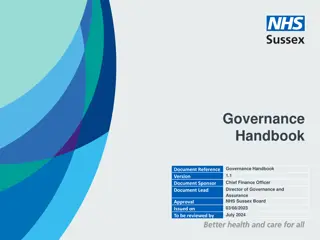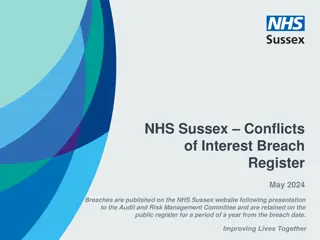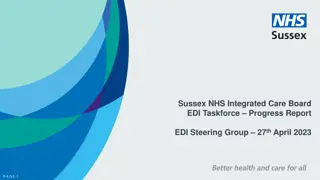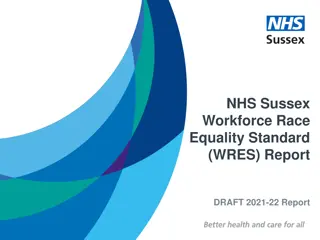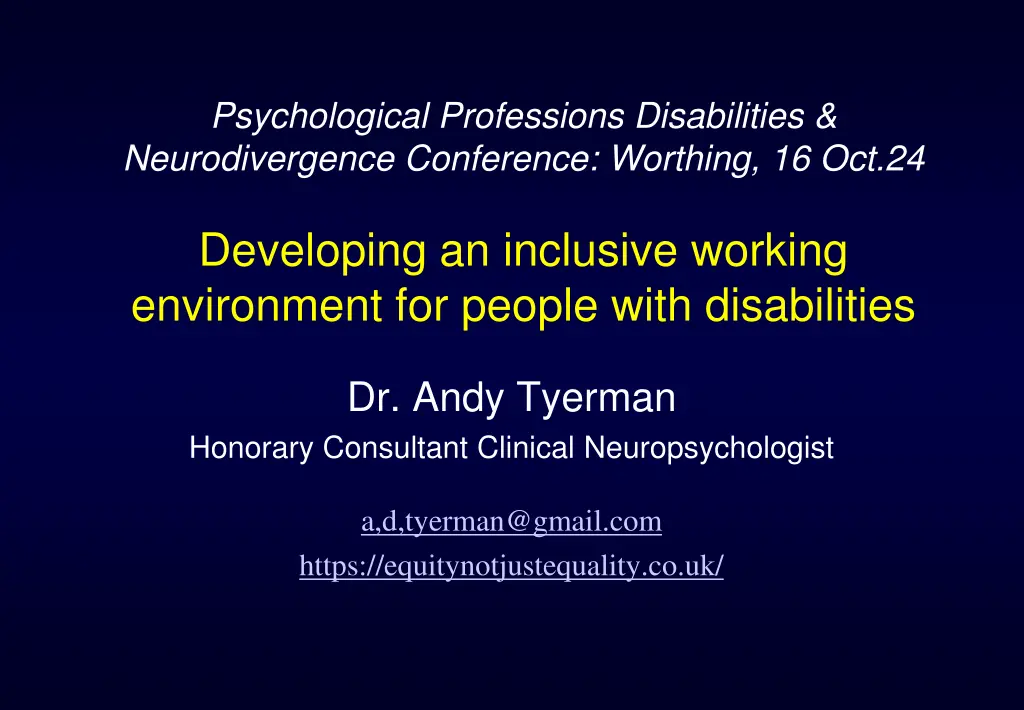
Developing Inclusive Work Environments for People with Disabilities - Conference Insights
Join Dr. Andy Tyerman, Honorary Consultant Clinical Neuropsychologist, as he explores the UN Convention on the Rights of Persons with Disabilities and the Equality Act to develop inclusive environments. Understand forms of disability discrimination, HCPC standards, resources for awareness, and more. Personal views shared. No legal advice given.
Download Presentation

Please find below an Image/Link to download the presentation.
The content on the website is provided AS IS for your information and personal use only. It may not be sold, licensed, or shared on other websites without obtaining consent from the author. If you encounter any issues during the download, it is possible that the publisher has removed the file from their server.
You are allowed to download the files provided on this website for personal or commercial use, subject to the condition that they are used lawfully. All files are the property of their respective owners.
The content on the website is provided AS IS for your information and personal use only. It may not be sold, licensed, or shared on other websites without obtaining consent from the author.
E N D
Presentation Transcript
Psychological Professions Disabilities & Neurodivergence Conference: Worthing, 16 Oct.24 Developing an inclusive working environment for people with disabilities Dr. Andy Tyerman Honorary Consultant Clinical Neuropsychologist a,d,tyerman@gmail.com https://equitynotjustequality.co.uk/
Outline UN Convention on the Rights of Persons with Disabilities Equality Act - forms of Disability Discrimination (DD) DD examples reported to me or observed by me HCPC revised Standards of Proficiency (Sept. 2023) Resources on DD awareness and enhancing practice Summary and Invitation NB: Personal views - no legal training, not legal advice.
UN Convention on the Rights of Persons with Disability (UNCRPD) Purpose: To promote, protect and ensure the full and equal enjoyment of all human rights and fundamental freedoms by all persons with disabilities (PwD), and to promote respect for their inherent dignity. Adopted by UN on 13.12.06, in force from 03.05.08. (The UK signed on 30.03.07 and ratified on 08.06.09) Focus on Art. 27 Work & Employment but see also 24. on Education, 25. Health, 26. Habilitation & Rehabilitation. . cont.
UNCRPD Article 2: Definitions Discrimination on the basis of disability: Any distinction, exclusion or restriction on the basis of disability which has the purpose or effect of impairing or nullifying the recognition, enjoyment or exercise, on an equal basis with others, of all human rights and fundamental freedoms in the political, economic, social, cultural, civil or any other field. It includes all forms of discrimination, including denial of reasonable accommodation [NB adjustment in Equality Act]. . cont
cont. UNCRPD Art 2: Definitions Reasonable accommodation : Necessary and appropriate modification and adjustments not imposing a disproportionate or undue burden, where needed in a particular case, to ensure to persons with disabilities the enjoyment or exercise on an equal basis with others of all human rights and fundamental freedoms (Art. 2) In order to promote equality and eliminate discrimination, States Parties shall take all appropriate steps to ensure that reasonable accommodation is provided (Art.5, para 3).
UNCRPD Key General Obligations To promote the training of professionals and staff working with persons with disabilities in the rights recognized in this Convention so as to better provide the assistance and services guaranteed by those rights. (Art. 4, para 1i). Health professionals to provide care of the same quality to PwD as to others . by, inter alia, raising awareness of the human rights, dignity, autonomy and needs of PwD. (Art 25, para d)
UNCRPD Art 27: Work and employment 13 specific points incl. highlighted staff relevant paragraphs: 1. States Parties recognize the right of PwD to work, on an equal basis with others; this includes the right to the opportunity to gain a living by work [that is] freely chosen or accepted in a labour market and a work environment that is open, inclusive and accessible to PwD. States Parties shall safeguard & promote the realization of the right to work, including for those who acquire a disability during the course of employment, by taking appropriate steps, including through legislation, to, inter alia: .. cont.
... cont. Art. 27: Work and employment a) Prohibit discrimination on the basis of disability with regard to all matters concerning all forms of employment, including conditions of recruitment, hiring, continuance of employment, career advancement and safe & healthy working conditions; b) Protect the rights of PwD, on an equal basis with others, to just and favourable conditions of work, including equal opportunities and equal remuneration for work of equal value, safe and healthy working conditions, including protection from harassment, and the redress of grievances; c) Ensure that PwD are able to exercise their labour and trade union rights on an equal basis with others;
cont. Art. 27: Work and employment d) Enable PwD to have effective access to general technical and vocational guidance programmes, placement services and vocational and continuing training; e) Promote employment opportunities & career advancement for PwD in the labour market, as well as assistance in finding, obtaining, maintaining and returning to employment; f) Promote opportunities for self-employment, entrepreneurship, the development of cooperatives and starting one s own business; g) Employ PwD in the public sector;
Art. 27: Work and employment h) Promote employment of PwD in the private sector through appropriate policies and measures, which may include affirmative action programmes, incentives & other measures; i) Ensure that reasonable accommodation is provided to PwD in the workplace; j) Promote the acquisition by PwD of work experience in the open labour market; k) Promote vocational and professional rehabilitation, job retention and return-to-work programmes for PwD. 2. Ensure that PwD are not held in slavery or in servitude, and are protected, on an equal basis with others, from forced or compulsory labour.
UK Equality Act 2010 and Disability The Equality Act (EqA) protects anyone who has, or has had, a disability against discrimination in a wide range of situations (including education, employment and as a service user) [While small employers may have more informal practices, fewer written policies and greater financial constraints, no employer is exempt because of size (EHRC, 2011, para 1.20)] (Equality Act 2010 Employment Statutory Code of Practice (EHRC, 2011). Key parts summarised in Tyerman et al. 2019.
Disability Discrimination: Equality Act (EqA) 2010 1. Direct discrimination: treating a person less favourably .. because of his or her disability. 2. Indirect discrimination: apparently neutral provision, criterion or practice which puts people with disability at disadvantage. 3. Discrimination arising from disability: treating a person unfavourably because of something arising in consequence of his or her disability. 4. Failure to make reasonable adjustments: employers have to ensure people with disability can access/progress in work. 5. Harassment and/or 6. Victimisation. (EHRC, 2011)
Obligations of employers outline In selection: assess objectively & not discriminate against PwD in arrangements for deciding who offered employment; in terms on which offer or by not offering employment (para 10.7) ( Arrangements includes all policies, criteria & practices incl. adverts, application & interview, not just decision-making). In employment: must not discriminate against PwD in: Terms of emp. pay, hours, bonuses, pensions, sickness, leave Access to opportunities (i.e. promotion, transfer, training etc.) Dismissal; or any other detriment (para 10.11-10.17) NB Policies/procedures may need amending to prevent disadvantage
Employers duty to make reasonable adjustments Take positive steps to ensure PwD can access & progress in employment not only not treating PwD unfavourably, but taking additional steps to ensure they can access jobs, education and services as easily as people without disability. Employers are also required to take reasonable steps to: Avoid substantial disadvantage arising from a provision, criterion or practice applied by or on behalf of employer. Remove or alter a physical feature or provide a reasonable means of avoiding such a feature .. Provide auxiliary aid (including auxiliary service). (EHRC, 2011)
Disability work adjustments - EHRC examples Making adjustments to premises Providing information in accessible formats Allocating some duties to another worker Altering hours of work or training Transferring worker to fill an existing vacancy Assignment to different place of work and/or home-working Allowing absence from work to attend for rehabilitation, assessment or treatment Training or mentoring (for a person with disability or others) Acquiring or modifying equipment .. cont.
Disability work adjustments - EHRC examples (2) Modifying procedures for testing or assessment Providing a reader or interpreter Providing supervision or other support Allowing a disabled worker to take period of disability leave Participating in supported employment schemes Employing a support worker to assist a disabled worker Modifying disciplinary or grievance procedures Adjusting redundancy selection criteria Modifying performance-related pay arrangements (EHRC, 2011)
Reasonale adjustments (RA): implementation factors Factors which might be taken into account when deciding what is a reasonable step include the following: likely effectiveness in preventing disadvantage the practicability of the step financial & other costs & extent of any disruption the extent of employer s financial or other resources financial or other assistance to help make adjustment the type and size of the employer (EHRC, 2011: para 6.28)
RA - Implementation Effective RAs often involve little or no cost or disruption and are therefore very likely to be reasonable to have to make unless another factor (e.g. ineffective) make it unreasonable (EHRC, 2011: para 6.5) . Even if significant cost may be cost-effective (e.g. relative to cost of recruiting & training new staff member) (EHRC, 2011: para 6.25) + more likely to be reasonable if organisation has substantial financial resources (NB as a whole, not service). Easier to implement, more likely to be reasonable ; however just because difficult does not mean not also reasonable .
Reasonable - legal judgment When duty applies, reasonableness alone determines whether has to be made this depends on individual circumstances (paras 6.30) Not personal opinion, legal judgment about what is reasonable to implement but if you can, why would you not do it anyway ? Taking all relevant issues into account, if an adjustment is reasonable, then it must be made, otherwise committing an act of unlawful DD (para 6.31-32).
Public Sector Equality Duty (PSED) Consider needs of all individuals in policy, delivering services & for own employees so that appropriate & accessible to all. Public bodies required to have due regard to the need to: eliminate unlawful discrimination, harassment, victimisation and any other conduct prohibited by EqA advance equality of opportunity between people with a disability and those without foster good relations between PwD and people without. (EHRC, 2014/2021)
House of Lords Select Committee: EqA 2010 & Disability (2016) Integrating disability legislation ignores a crucial distinction between disability and other protected groups, for whom equality of opportunity is largely achieved by equality of treatment. In contrast, equality for PwD often requires different treatment. Problems with provision of RAs in almost every part of society . Highlight poor understanding of employers duty to reduce disadvantage to achieve equality in practice (para 204- 6), some still see as favouritism . 19 recommendations Govt., PSED, RA & access to justice.
Women & Equalities Committee (2019a&b) Enforcing the Equality Act: What little enforcement is happening insufficient to tackle systemic or routine discrimination that too many experience as a simple fact of life > Need a fundamental shift in enforcement of the EqA. Non-disclosure agreements: Serious concerns of employers covering up allegations of workplace discrimination through NDAs, which employees often felt they had to sign. NDAs should not be used to silence victims of discrimination and harassment ; employers and their legal advisers should not be complicit in using NDAs to cover up allegations of unlawful acts .
How we treat our own: 56 trainees and psychologists with doctoral training in clinical, counseling, school, or rehabilitation psychology in USA: majority of participants reported experiencing disability- related discrimination during training. less than a one third had received mentorship from psychologists with disabilities; less than half disclosed disability to univ. disability services, with many relied on informal accommodations alone. Programs should not expect disability services to provide all support for PwD, esp. in clinical training (Lund et al. 2014).
How we treat our own 2: In UK, 6 trainees reported additional practical & attitudinal challenges, many arising from a training system aimed at those in healthy bodies , with anything else perceived as inconvenient and troublesome : 3 themes identified: Everyday Battles , Identity , Silence & Speaking . On raising concerns, rather than considering the role of a system with structural inequalities, staff located problems within the trainees with difficulties often as pertaining to individual competence issues (Coop, 2018). + Current survey being undertaken by current trainee CP
DD examples reported to me or observed Disability Discrimination (DD) Examples Reported to me or observed by me in the following contexts: Neurorehabilitation (NR) (1979 2021) 8 yrs in/out-patient > 5 yrs community NR general 29 yrs community brain injury rehabilitation incl. vocational rehabilitation programme + inter-disciplinary head of service Since retirement (2021 - ) Honorary teaching, research & consultancy + Trustee with Headway UK (10 yrs +) Voc. Rehab. Assoc. (3 yrs). Personal / family context Family + friends of family members with disability. NB This excludes large number of DD experiences in legal claims.
Notes on DD Examples 2010 > Concerns of all forms of DD of trainee and qualified psychologists, professional colleagues and clients, plus reports or observations of associated unprofessional misconduct by psychologists and other parties. The examples include many different examples or forms of DD experienced by the same (as well as different) individuals. This is particularly true for trainee clinical psychologists who are not free to move to a new job, as other employees are. Some of those reported to have engaged in DD conduct are cited in single examples, some in several examples and for a few individual clinical psychologists in many examples.
Interim DD examples Context Example Context CP / NHS based 311+ Other Total Educ. / training 6 317+ Service provision 83+ - 83+ Employment 138+ 10 148+ All examples 532+ 16 548+
All examples organisation involved Number of examples (n=548) 2725 14 Univ NHS 281 201 Other Emp DWP Other
All: DD type & other concerns All examples n=548 200 184 180 160 140 120 100 90 74 80 69 71 60 41 40 19 20 0 Direct Indirect Arising Adjust. Harass. Victim. Other
All examples: DD concerns by Context Educ/Train. Clinical Employment 120 100 80 60 40 20 0 Direct Indirect Arising Adjust. Harass. Victim. Other
Education & Training: Context Example Context Psychol Other Total U/G or PG 1 2 3 Postgraduate 3 0 3 App. Clin. Train. 51 - 51 Clinical Training 260 - 260 All Ed &T 315 2 317
App. Clin.Train. DD + related concerns Number of examples (n=51) 40 35 35 30 25 20 15 10 6 4 5 3 0 0 3 0 Direct Indirect Arising Adjust. Harass. Victim. Other
Clin. Train. DD + related concerns Number of examples (n=260) 100 90 86 80 70 60 53 50 45 39 40 30 20 13 16 10 8 0 Direct IndirectArising Adjust. Harass. Victim. Other
Clinical Practice: Context Example Context Psychol/NHS Other Total Benefits Assess. 25+ - 25+ COVID Lockdown 21+ - 21+ NHS Service provision 17+ - 17+ Employer: VR prog. 17+ - 17+ Headway UK support 2+ 2+ - Publican 1 - 1 All Clinical 81+ 2+ 83+
Clinical: DD type + related concerns Number of examples (n=83) 30 26 25 22 23 20 15 11 10 5 1 0 0 0 Direct IndirectArising Adjust Harass. Victim Other
Staff employment: Context Example Context Psychol. Other Total Job applicants NHS 4 38* 42* Appointed NHS post 34 0 34 In-post in NHS 37 25 62 In post: other employer - 10 10 All staff employment 75 73 148* NB These totals include 18 misrepresentations of CP reports in legal claim
NHS staff recruitment: DD + related concerns Number of examples (n=76) 35 30 29 27 25 20 15 10 10 9 5 1 0 0 0 Direct Indirect Arising Adjust. Harass. Victim. Other NB The 29 Direct includes the 18 misrepresentations of CP reports in legal claim
NHS Staff in post: DD + related concerns Number of examples (n=62) 35 33 30 25 20 15 10 8 8 5 5 5 2 1 0 Direct Indirect Arising Adjust Harass. Victim. Other
NHS Employment: Agents involved Number of examples (n=62) 2 2 3 15 Line Manager Serv. Man. Gen. Man. Trust Other HR IT Clients Other 8 9 15 8
All: DD type & other concerns Number of examples (n=548) 69 71 19 Direct Indirect Arising Adjustments Harassment Victimisation Other 74 41 90 184
Complaints, concerns and legal claims Informal & formal complaints and grievances Appeals and independent investigations Concerns to relevant regulatory bodies Office of Independent Adjudicator (Higher Education) BPS Accreditation and Partnership Team HCPC Education & HCPC Fitness to Practice NHS Ombudsman Information Commissioners Office Legal claims (County Court / Employment Tribunal) ? EHRC (or, as last resort, ECHR / UNCRPD)
Successful RA legal claims some examples: Refusal to vary standard assessment test or format Failure to make reasonable adjustments at interview Refusal to provide a dedicated parking space Not making adjustments, as none recommended by GP ! Failure to recognise disadvantage > inefficiency Training delayed > dismissal on capability grounds Insufficient adjustments > do job but not to best of ability Declining request to transfer to another role - RA required Disability leave adjustment removed > dismissal Failure to maintain rate of pay on disability redeployment
HCPC Revised Standards of Proficiency Under revised EDI section (5.0) registrants must: 5.0 recognise impact of culture, equality and diversity on practice and practise in a non-discriminatory and inclusive manner. 5.1 respond appropriately to needs of all different groups and individuals in practice, recognising this can be affected by difference of any kind including but not limited to, protected characteristics, intersectional experiences & cultural differences. 5.2 understand equality legislation and apply it to practice. . HCPC SoP 2023
. HCPC Registrants must: 5.3 recognise the potential impact of their own values, beliefs and personal biases (which may be unconscious) on practice & take personal action to ensure all service users/carers are treated appropriately with respect and dignity 5.4 understand the duty to make RA in practice and be able to make and support RA adjustments in their and others practice 5.5 recognise the characteristics and consequences of barriers to inclusion, including for socially isolated groups 5.6 actively challenge these barriers, supporting the implementation of change wherever possible . HCPC SoP 2023
HCPC Registrants must: 5.7 recognise that regard to equality, diversity and inclusion needs to be embedded in the application of all HCPC standards, across all areas of practice. 5.8 understand the impact of differences of any kind, including, but not limited to, the protected characteristics, intersectional experiences and cultural differences, on psychological wellbeing or behaviour including how these differences may result in experiences of marginalization. 5.9 understand the requirement to adapt practice to meet the needs of different groups and individuals
Disability Discrimination Awareness Resources (www.equitynotjustequality.co.uk) Background / summary concerns / links / 2023 article Disability Discrimination Awareness Questionnaire. Disability Discrimination Practice Checklists x 5 Suggested Action Recommended reading Training presentations and videos Disability Discrimination Example Proformas
Disability Discrimination Awareness Questionnaire DDAQ has 30 questions taken from Equality Act: Definition and Eligibility (7 Qs) Direct discrimination (3 Qs) Indirect discrimination (4 Qs) Discrimination arising from disability (2 Qs) Failure to make reasonable adjustments (10 Qs) Harassment / victimisation (2 Qs) Other unlawful behaviour (2 Qs)
DDAQ responses to date Responses to date confirm lack of awareness of aspects of the Equality Act with a median of 18/30 (range 4-30): half have over 10 yrs experience; 81% work for NHS. Most of this group report having had a reason to seek such information. Items with lower awareness include definition of disability, link to medical diagnosis, indirect discrimination, H&S risk, limited grounds for not implementing adjustments & victimisation. Self ratings increase to median awareness of 8/10 as a result of DDAQ completion from retrospective median prior rating of 6. Much greater awareness raising would be expected for those with less prior knowledge..
Disability Discrimination Practice Checklists Health & other Professionals (DDPC-Pr) (25 items) Service Managers (Public Sector) (DDPC-SM) (25 items) (Training) Course Tutors (DDPC-CT) (25 items) Vocational/Employment Specialist (DDPC-V/ES) (25 items) Assistants (DDPC-Asst.) (20 items) ? Child Health Practitioners + ? teachers etc.
Suggested Action 1. Complete and submit the DDAQ. 2. Complete DDPC relevant to your specific work role(s). 3. Read sections of EHRC statutory codes/technical guidance relevant to work role + good practice sections/chapters. 4. Read UNCRPD (2006) and/or summary (Tyerman, 2023). 5. Review employer s EDI policies (+ if NHS annual WDES). 6. Read / note guidance relevant to your specific work role(s)



